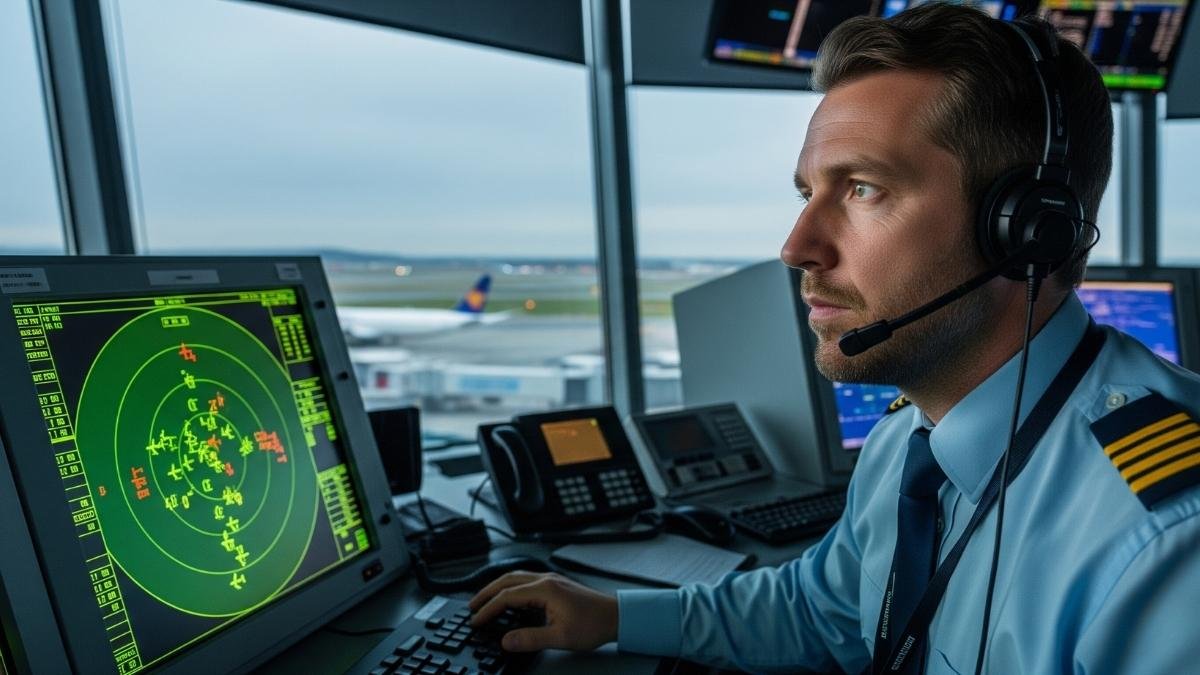
You’re 35,000 feet up, sipping your coffee, when suddenly the plane drops. Your stomach lurches. The overhead bins rattle. That person three rows up who was heading to the bathroom? They just hit the ceiling.
Here’s what every air traffic controller and pilot wishes you knew: That person got hurt because they weren’t wearing their seatbelt. If they had been buckled in, they’d be fine right now.
I know, I know. You’re thinking, “But the seatbelt sign wasn’t even on!”
That’s exactly the point.
The shocking truth about turbulence injuries

Let me share a statistic that’ll change how you think about flying forever: Nearly 100% of passenger injuries during turbulence happen to people who aren’t wearing seatbelts.
Think about that for a second. We’re talking about hundreds of incidents, thousands of injuries, and the pattern is always the same. Belted passengers walk away. Unbelted passengers get hurt—sometimes seriously.
The National Transportation Safety Board has been tracking this data for years. From 2009 to 2022, they recorded 163 serious turbulence injuries. Want to guess how many happened to be properly belted passengers?
Almost zero.
The numbers don’t lie
Here’s the breakdown that should make you rethink your in-flight habits:
- 65,000 flights encounter moderate turbulence every year in the US alone
- 5,500 flights experience severe turbulence annually
- 2 billion passengers fly globally each year
- Only 50 people suffer serious turbulence injuries worldwide
Those are pretty good odds—if you’re wearing your seatbelt.
What pilots and controllers see
Perception vs Reality in the Cockpit
advance
advance
advance
hits
Patrick Smith has been flying commercial jets for over 30 years. When passengers are panicking about what feels like a 500-foot drop, here’s what his instruments show: 10 to 40 feet of actual altitude change.
“From a pilot’s perspective, turbulence is ordinarily seen as a convenience issue, not a safety issue,” Smith explains. “We’re not worried about the wings falling off; we’re trying to keep everyone’s coffee where it belongs.”
But here’s the kicker—while pilots stay calm because they understand what’s happening, they’re also doing something passengers often ignore: They’re always strapped in.
The invisible work of air traffic control
Ever wonder why your pilot suddenly announces “We’ve got some choppy air ahead” when the skies look clear?
Air traffic controllers are your early warning system. They’re constantly:
- Monitoring real-time weather data
- Collecting reports from aircraft ahead of you
- Routing flights around known turbulence zones
- Giving pilots 5-20 minutes’ advance notice of rough air
When that seatbelt sign comes on during a smooth flight, it’s not random. It’s intelligence.
The climate change factor you need to know

Here’s something that should grab your attention: Clear-air turbulence—the kind you can’t see coming—has increased 55% over the last 40 years.
This isn’t just random weather. It’s climate change making flying bumpier, and it’s only going to get worse.
Why invisible turbulence is so dangerous
Clear-air turbulence happens in clear skies. No clouds. No storms. No warning.
It strikes at cruising altitude where passengers expect the smoothest ride. You’re walking to the bathroom, reaching for the overhead bin, or just sitting there with your seatbelt off because everything seems fine.
Then wham—the plane hits an invisible wall of unstable air.
University of Reading research projects that this type of turbulence could double or triple in the coming decades. Translation? The skies are getting more dangerous for unprepared passengers.
Real stories that’ll make you buckle up
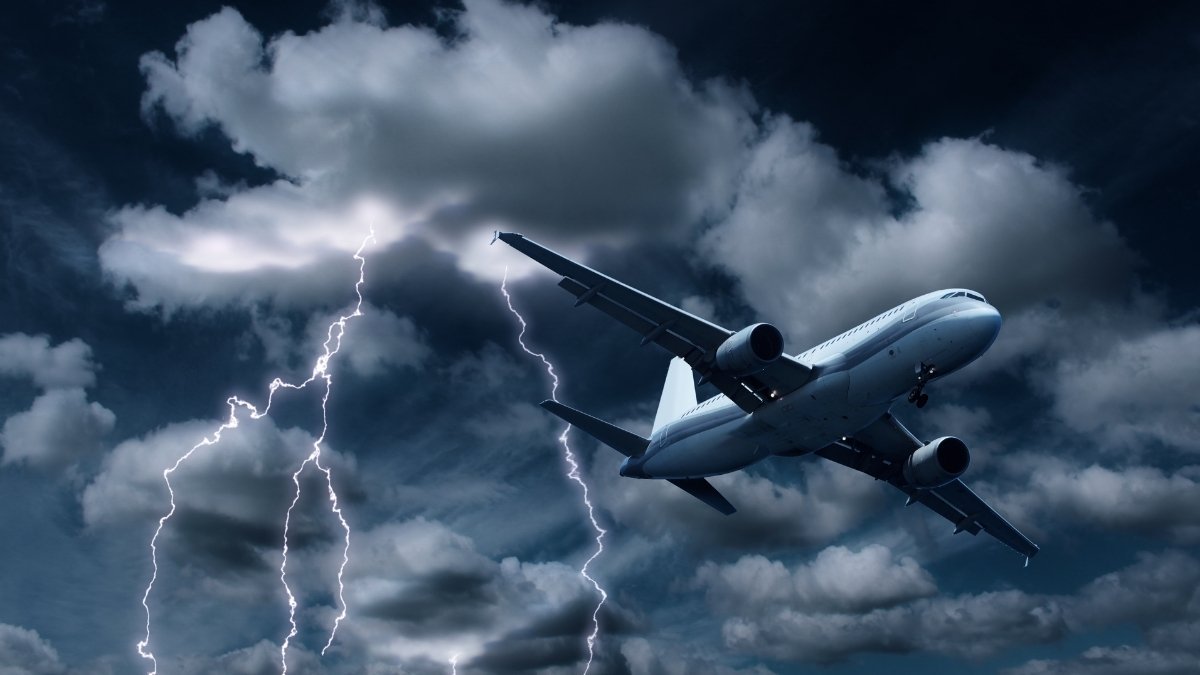
United Airlines Flight 826: The Pacific nightmare
December 1997. A Boeing 747 with 374 passengers encounters severe clear-air turbulence over the Pacific Ocean.
The result? One death, 18 serious injuries, 161 minor injuries.
The person who died? She wasn’t wearing her seatbelt.
Everyone properly secured survived one of the most violent turbulence encounters in aviation history. The seatbelt sign had come on two minutes before impact, but many passengers missed the warning.
Hawaiian Airlines Flight 35: A preventable disaster
Fast forward to December 2022. An Airbus A330 hits severe turbulence approaching Honolulu. Passengers describe being “violently thrown into the ceiling and luggage compartments.”
36 injuries. 20 hospitalizations.
The pattern? Passengers who stayed belted experienced the same violent forces but walked away unharmed.
Singapore Airlines Flight 321: The heart-stopping encounter
May 2024. London to Singapore route. One passenger died of a heart attack during severe turbulence. 104 others were injured, and 20 needed intensive care.
Passenger accounts were consistent: “Anyone who was injured was not wearing a seatbelt.”
Why your brain tricks you about turbulence

Your body is designed to detect danger, but it’s not great at assessing airplane safety. Here’s what’s happening when you think you’re going to die:
What you feel: The plane is dropping 1,000 feet!
Reality: Maybe 20 feet of altitude change
What do you think: The wings are going to snap!
Reality: Aircraft are tested to withstand forces far beyond anything turbulence can produce
What scares you: The plane is out of control!
Reality: Pilots often don’t even adjust controls during moderate turbulence
The comfort vs. safety disconnect
When pilots change altitude to avoid turbulence, it’s usually for passenger comfort, not safety. They’re trying to find smoother air so you can enjoy your flight—not because the current conditions are dangerous.
But here’s the thing: even “comfort” turbulence can seriously injure an unbelted passenger.
The technology revolution you don’t see
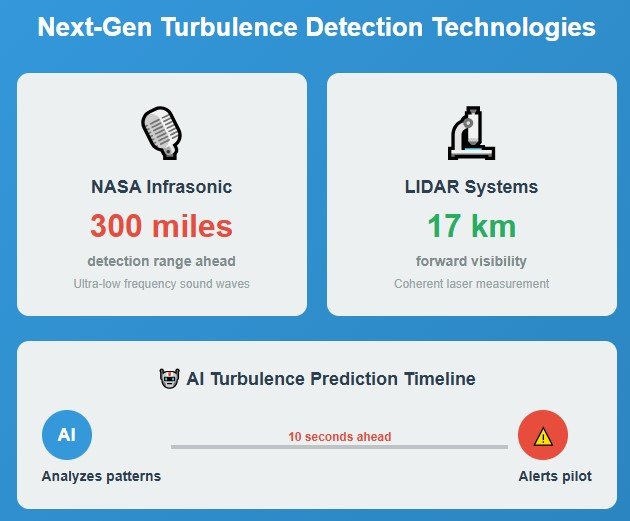
While you’re gripping your armrest, aviation technology is getting incredibly sophisticated at detecting and avoiding turbulence.
Game-changing innovations

NASA’s new infrasonic microphones can detect clear-air turbulence over 300 miles away using ultra-low-frequency sound waves. Having five minutes’ warning instead of five seconds.
Advanced LIDAR systems give pilots 10-17 kilometers of forward visibility into turbulence—like having X-ray vision for rough air.
AI prediction algorithms can now forecast turbulence encounters with unprecedented accuracy, analyzing atmospheric patterns humans can’t even detect.
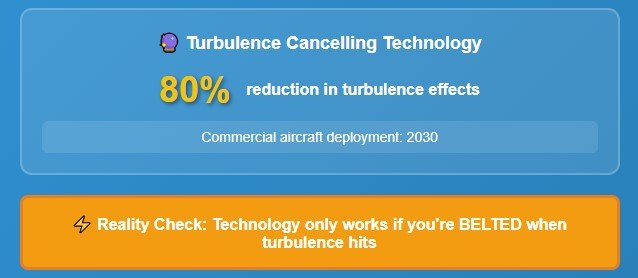
But here’s the reality check: None of this technology works if you’re not buckled in when turbulence hits.
The seat location strategy
Aircraft Turbulence Comfort Zones
Want to know where pilots and flight attendants sit when they fly as passengers? Over the wings.
It’s the smoothest spot on the plane—closest to the aircraft’s center of gravity. The worst place? The very back, where every movement gets amplified.
But honestly? Your seat location matters way less than your seatbelt usage.
The time-of-day advantage
Flight crews know this secret: Early morning and nighttime flights are statistically smoother.
Afternoon flights, especially over land, encounter more thermal turbulence as the sun heats the ground. Desert airports like Las Vegas and Phoenix are particularly bumpy during daytime hours.
Planning a connecting flight? Choose the early bird departure when possible.
What does that seatbelt sign mean
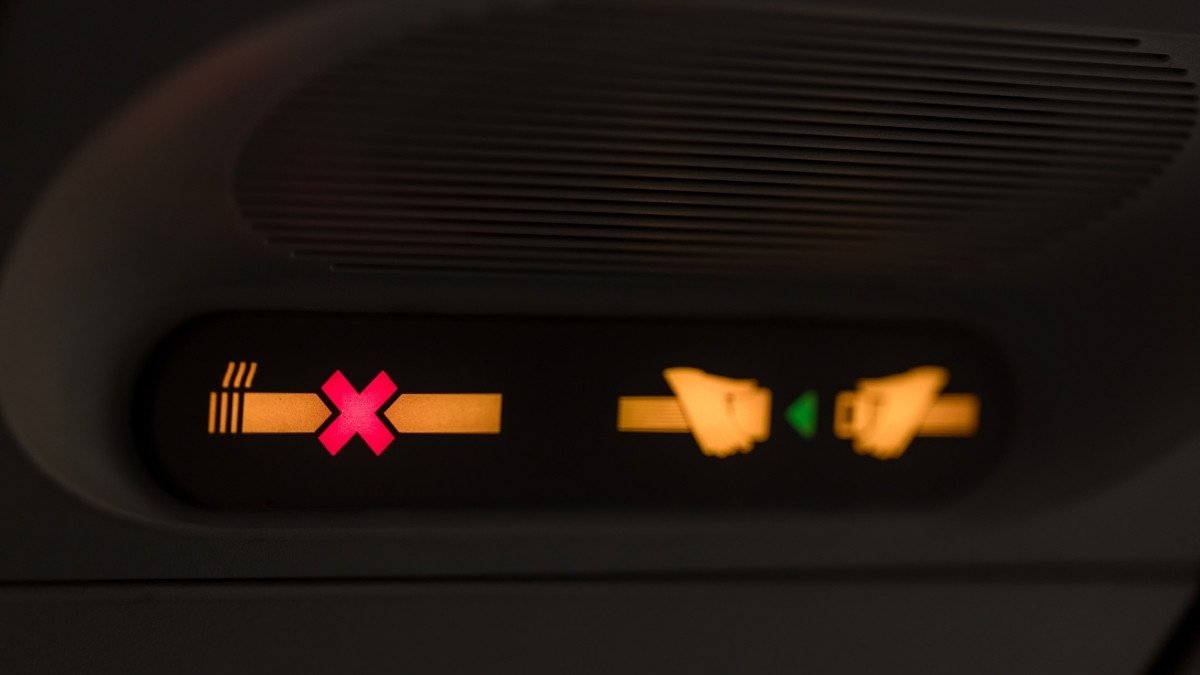
Here’s insider knowledge that changes everything: Professional pilots treat the seatbelt sign as a predictive tool, not a reactive warning.
When Captain Scott Raynor illuminates the seatbelt sign, here’s his protocol:
- Turn on the sign before rough air hits
- Alert flight attendants to prepare for specific turbulence types
- Monitor conditions continuously
- Keep the sign on until completely clear
The two-minute rule
Most turbulence injuries happen in those crucial moments between when the seatbelt sign comes on and when turbulence hits.
Passengers think they have time to finish their trip to the bathroom, grab something from overhead, or just ignore the sign because conditions seem fine.
That’s exactly when turbulence strikes.
The professional mindset you need to adopt

John Cox, a retired airline pilot and USC instructor, puts it perfectly: “Every safety professional that I know, when we’re on an airplane, if I’m not up walking around for a reason, then my seat belt’s at least loosely fastened.”
Notice that phrase: “at least loosely fastened.”
Aviation professionals don’t just wear seatbelts during turbulence. They wear them constantly, loosening or tightening as needed, but never completely removing them unless necessary.
The habit that saves lives
Make continuous seatbelt use your default flying behavior.
- Boarding the plane? Belt on.
- Smooth cruise flight? Belt on (loose).
- Reading, sleeping, working? Belt on.
- Only unbelt for bathroom breaks and essential movement.
This simple habit shift transforms you from a turbulence victim into someone who’s always prepared.
The surprising costs of turbulence
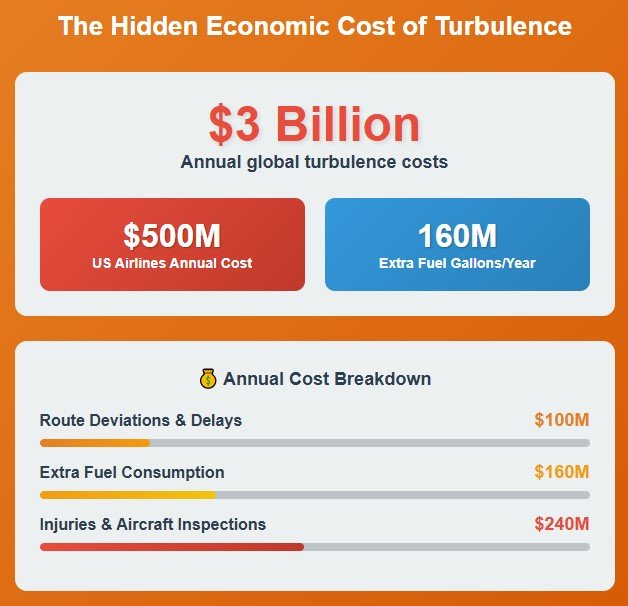
Here’s something that might shock you: Airlines spend $150-500 million annually in the US just dealing with turbulence.
That includes:
- $160 million in extra fuel for route changes
- $100 million in flight delays and diversions
- Millions in injury-related costs and aircraft inspections
- Countless crew hours managing turbulence encounters
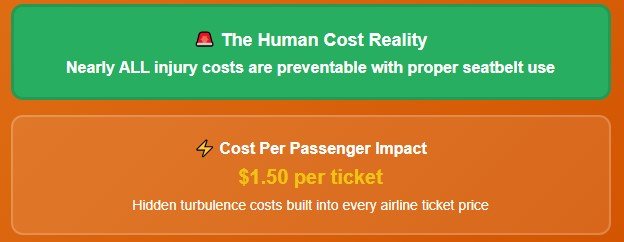
But the human cost is what matters. Every year, dozens of people suffer serious injuries that are completely preventable with proper seatbelt use.
Your turbulence survival playbook

Ready to fly like a professional? Here’s your action plan:
Before takeoff:
- Adjust your seatbelt to a comfortable looseness
- Keep it on throughout the entire flight unless walking
- Choose morning flights when possible for smoother air
- Select seats over the wings if you’re turbulence-sensitive
When the seatbelt sign illuminates:
- Immediately tighten your belt—don’t wait for turbulence to start
- Return to your seat immediately if you’re up and about
- Secure loose items around you
- Stay calm—remember, pilots expect this and are prepared
During turbulence:
- Keep your seatbelt tight until the sign goes off
- Avoid the bathroom even if you need to go
- Don’t stand up to help someone else—you’ll just create two victims
- Trust the process—aircraft are built for this
The bottom line that could save your life
After researching hundreds of turbulence incidents, interviewing aviation professionals, and analyzing decades of safety data, the message is crystal clear:
Your safety during turbulence has almost nothing to do with the aircraft, the pilots, or the weather. It has everything to do with whether you’re wearing your seatbelt.
Every air traffic controller, commercial pilot, flight attendant, and aviation safety expert I’ve encountered shares the same perspective: Turbulence injuries are almost entirely preventable.
The technology exists. The expertise is there. The aircraft are incredibly safe.
The only variable is you.
Take action today
The next time you fly, I want you to try something. From the moment you sit down until you reach your destination, keep that seatbelt loosely fastened unless you absolutely need to move.
Notice how it feels. Pay attention to your peace of mind when turbulence hits.
You’ll realize what every aviation professional already knows: The best turbulence protection isn’t better weather radar or advanced warning systems.
It’s the simple click of a seatbelt buckle.
Your future self—and your family waiting for you at your destination—will thank you for making this one small change that could literally save your life.
What’s your biggest concern about flying through turbulence? Have you ever experienced a scary turbulence encounter? Share your story in the comments—I’d love to hear about your experiences and answer any questions you might have about staying safe at 35,000 feet.






